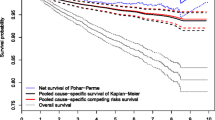Abstract
Several authors have indicated that incorrectly classified cause of death for prostate cancer survivors may have played a role in the observed recent peak and decline of prostate cancer mortality. Motivated by the suggestion we studied a competing risks model where other cause of death may be misattributed as a death of interest. We first consider a naïve approach using unconstrained nonparametric maximum likelihood estimation (NPMLE), and then present the constrained NPMLE where the survival function is forced to be monotonic. Surprising observations were made as we studied their small-sample and asymptotic properties in continuous and discrete situations. Contrary to the common belief that the non-monotonicity of a survival function NPMLE is a small-sample problem, the constrained NPMLE is asymptotically biased in the continuous setting. Other isotonic approaches, the supremum (SUP) method and the Pooled-Adjacent-Violators (PAV) algorithm, and the EM algorithm are also considered. We found that the EM algorithm is equivalent to the constrained NPMLE. Both SUP method and PAV algorithm deliver consistent and asymptotically unbiased estimator. All methods behave well asymptotically in the discrete time setting. Data from the Surveillance, Epidemiology and End Results (SEER) database are used to illustrate the proposed estimators.
Similar content being viewed by others
References
Adler RJ (1990) An introduction to continuity, extrema and related topics for general gaussian processes. IMS, Hayward, CA
Andersen PK, Gill RD (1982) Cox’s regression model for counting processes: a large sample study. Ann Stat 10: 1100–1120
Andersen PK, Borgan Ø, Gill RD, Keiding N (1993) Statistical models based on counting processes. Springer, New York
Ayer M, Brunk HD, Ewing GM, Reid WT, Silverman E (1955) An empirical distribution function for sampling with incomplete information. Ann Math Stat 26: 641–647
Barlow RE, Bartholomew DJ, Bremner JM, Brunk HD (1972) Statistical inference under order restrictions: the theory and application of isotonic regression. Wiley, New York
Craiu RV, Duchesne T (2004) Inference based on the EM algorithm for the competing risks model with masked causes of failure. Biometrika 91: 543–558
Dewanji A, Sengupta D (2003) Estimation of competing risks with general missing pattern in failure types. Biometrics 59: 1063–1070
Dinse GE (1982) Nonparametric estimation for partially-complete time and type of failure data. Biometrics 38: 417–431
Dinse GE (1986) Nonparametric prevalence and mortality estimators for animal experiments with incomplete cause-of-death data. J Am Stat Assoc 81: 328–336
Feuer EJ, Merrill RM, Hankey BF (1999) Cancer surveillance series: interpreting trends in prostate cancer-part II: cause of death misclassification and the recent rise and fall in prostate cancer mortality. J Natl Cancer Inst 91: 1025–1032
Flehinger BJ, Reiser B, Yashchin E (1998) Survival with competing risks and masked causes of failures. Biometrika 85: 151–164
Gao G, Tsiatis AA (2005) Semiparametric estimators for the regression coefficients in the linear transformation competing risks model with missing cause of failure. Biometrika 92: 875–891
Goetghebeur E, Ryan L (1995) Analysis of competing risks survival data when some failure types are missing. Biometrika 82: 821–833
Hoffman RM, Stone SN, Hunt WC, Key CR, Gilliland FD (2003) Effects of misattribution in assigning cause of death on prostate cancer mortality rates. Ann Epidemiol 13: 450–454
Lin DY, Ying Z (1994) Semiparametric analysis of the additive risk model. Biometrika 81: 61–71
Little RJA, Rubin DB (1987) Statistical analysis with missing data. Wiley, New York
Prentice RL, Kalbfleisch JD, Peterson AV, Flournoy N, Farewell VT, Breslow NE (1978) The analysis of failure times in the presence of competing risks. Biometrics 34: 541–554
Tsiatis A (1975) A nonidentifiability aspect of the problem of competing risks. Proc Natl Acad Sci 72: 20–22
Author information
Authors and Affiliations
Corresponding author
Rights and permissions
About this article
Cite this article
Ha, J., Tsodikov, A. Isotonic estimation of survival under a misattribution of cause of death. Lifetime Data Anal 18, 58–79 (2012). https://doi.org/10.1007/s10985-011-9210-4
Received:
Accepted:
Published:
Issue Date:
DOI: https://doi.org/10.1007/s10985-011-9210-4




